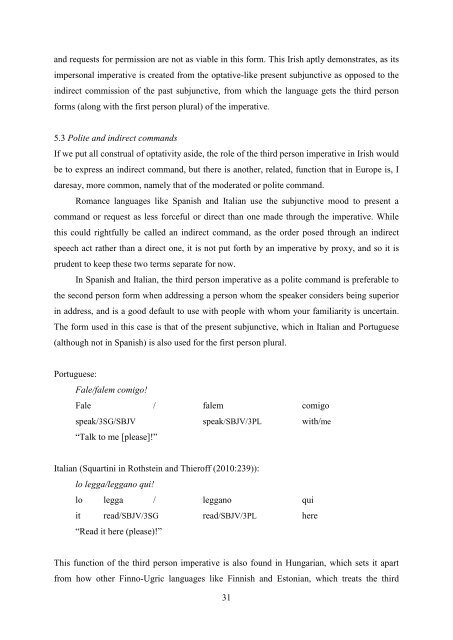The function of non-canonical imperatives in the languages of Europe
The function of non-canonical imperatives in the languages of Europe
The function of non-canonical imperatives in the languages of Europe
Create successful ePaper yourself
Turn your PDF publications into a flip-book with our unique Google optimized e-Paper software.
and requests for permission are not as viable <strong>in</strong> this form. This Irish aptly demonstrates, as its<br />
impersonal imperative is created from <strong>the</strong> optative-like present subjunctive as opposed to <strong>the</strong><br />
<strong>in</strong>direct commission <strong>of</strong> <strong>the</strong> past subjunctive, from which <strong>the</strong> language gets <strong>the</strong> third person<br />
forms (along with <strong>the</strong> first person plural) <strong>of</strong> <strong>the</strong> imperative.<br />
5.3 Polite and <strong>in</strong>direct commands<br />
If we put all construal <strong>of</strong> optativity aside, <strong>the</strong> role <strong>of</strong> <strong>the</strong> third person imperative <strong>in</strong> Irish would<br />
be to express an <strong>in</strong>direct command, but <strong>the</strong>re is ano<strong>the</strong>r, related, <strong>function</strong> that <strong>in</strong> <strong>Europe</strong> is, I<br />
daresay, more common, namely that <strong>of</strong> <strong>the</strong> moderated or polite command.<br />
Romance <strong>languages</strong> like Spanish and Italian use <strong>the</strong> subjunctive mood to present a<br />
command or request as less forceful or direct than one made through <strong>the</strong> imperative. While<br />
this could rightfully be called an <strong>in</strong>direct command, as <strong>the</strong> order posed through an <strong>in</strong>direct<br />
speech act ra<strong>the</strong>r than a direct one, it is not put forth by an imperative by proxy, and so it is<br />
prudent to keep <strong>the</strong>se two terms separate for now.<br />
In Spanish and Italian, <strong>the</strong> third person imperative as a polite command is preferable to<br />
<strong>the</strong> second person form when address<strong>in</strong>g a person whom <strong>the</strong> speaker considers be<strong>in</strong>g superior<br />
<strong>in</strong> address, and is a good default to use with people with whom your familiarity is uncerta<strong>in</strong>.<br />
<strong>The</strong> form used <strong>in</strong> this case is that <strong>of</strong> <strong>the</strong> present subjunctive, which <strong>in</strong> Italian and Portuguese<br />
(although not <strong>in</strong> Spanish) is also used for <strong>the</strong> first person plural.<br />
Portuguese:<br />
Fale/falem comigo!<br />
Fale / falem comigo<br />
speak/3SG/SBJV speak/SBJV/3PL with/me<br />
“Talk to me [please]!”<br />
Italian (Squart<strong>in</strong>i <strong>in</strong> Rothste<strong>in</strong> and Thier<strong>of</strong>f (2010:239)):<br />
lo legga/leggano qui!<br />
lo legga / leggano qui<br />
it read/SBJV/3SG read/SBJV/3PL here<br />
“Read it here (please)!”<br />
This <strong>function</strong> <strong>of</strong> <strong>the</strong> third person imperative is also found <strong>in</strong> Hungarian, which sets it apart<br />
from how o<strong>the</strong>r F<strong>in</strong>no-Ugric <strong>languages</strong> like F<strong>in</strong>nish and Estonian, which treats <strong>the</strong> third<br />
31
















